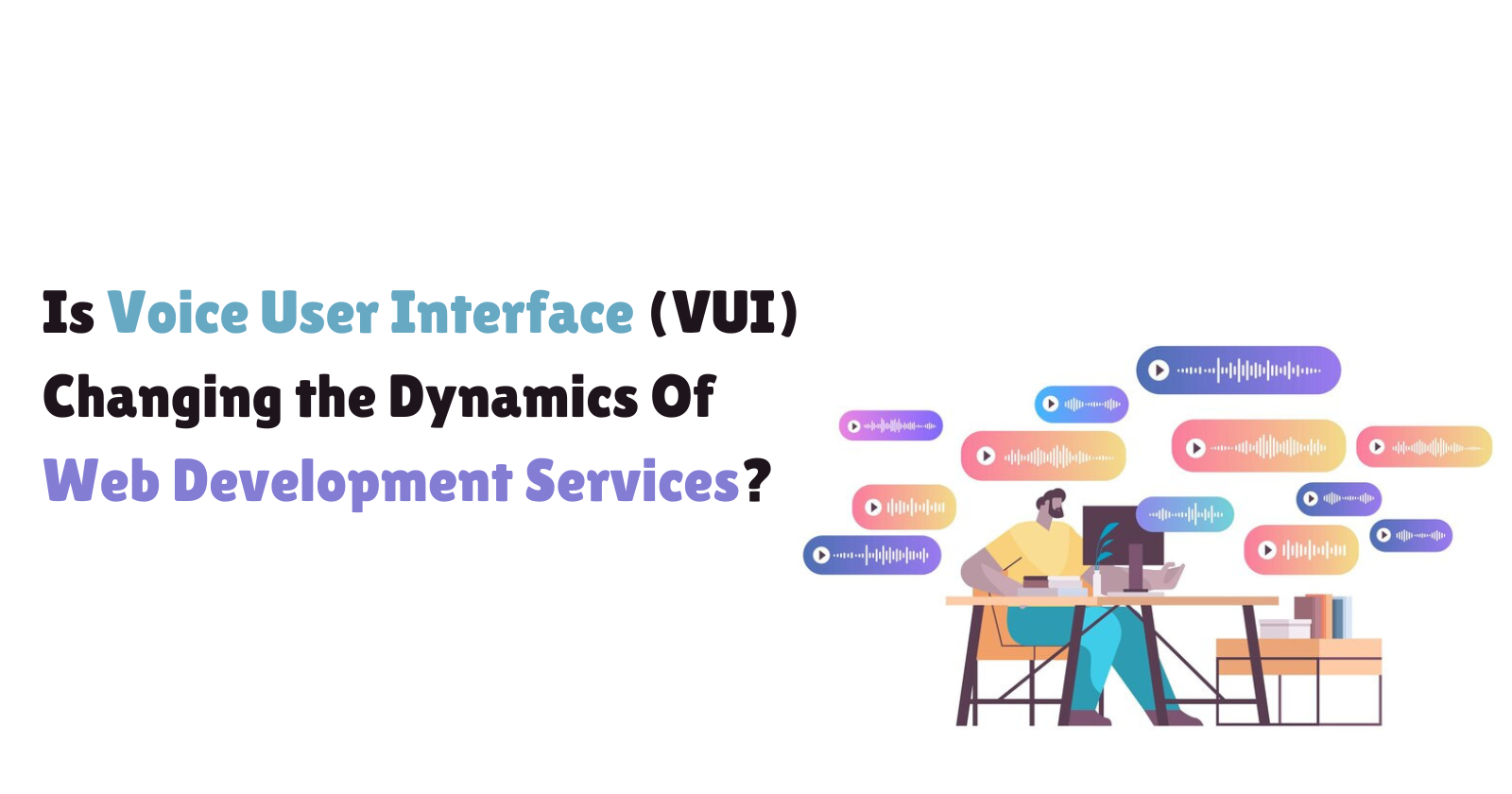Is Voice User Interface (VUI) Changing the Dynamics Of Web Development?
 Dipen Patel
Dipen Patel
Today, where multitasking is second nature, adding another step, such as typing or tapping, to engage with websites can feel tedious for researchers. We believe that at least interacting with your smartphone should be simple when you're attempting to finish things fast while juggling other responsibilities.
This is where voice user interfaces (VUI) come in.
It's much simpler to engage with webpages and apps when you can talk to your smartphone instead of using clicks and taps via VUI. Voice commands are quickly replacing physical contact as the preferred way to accomplish tasks, such as asking Siri to play your favorite music or asking Alexa to check the weather.
The Growing Importance of VUI in Modern User Experiences:
It is considerably less stressful when we simply speak and finish tasks quickly and easily rather than pausing everything to type or tap.
Here are some numbers from the research:
The ability to control devices without physical interaction is the most compelling reason for voice assistant adoption.
Voice User Interfaces (VUI) aren't just for techies. Additionally, they're changing how the internet functions for everyone, including people with disabilities. The web is more inclusive and accessible for everyone when people with visual impairments may use VUIs to navigate it hands-free.
Additionally, voice search is altering the way websites must be developed, so it's not just about usability.
Web development services must change as more consumers conduct voice searches instead of typing. As people are now requesting information via voice search, websites must now optimize for voice search, emphasizing conversational language and questions.
Top 4 Benefits of Implementing VUI in Web Development:
Enhanced User Engagement: Websites can feel much more interactive when voice interactions are used. Users can interact with the website by speaking to it rather than merely clicking through pages, which captures their interest and keeps them on it longer.
Accessibility: Voice commands aren't only cool; they're essential to make websites accessible to all users, including those with disabilities. Voice commands can be quite helpful for people who have trouble typing or who have trouble seeing the screen.
Higher User Satisfaction: Voice commands streamline the process by eliminating the need for users to fumble with menus or keyboards; they simply need to speak what they want.
Competitive Advantage: Adding voice-activated capabilities to your website puts you ahead of the curve because many websites are still in the early stages of development. It can help you outperform the competition and draw in more users.
Key Components of a Voice User Interface in Web Development Services
Voice Recognition Technology: Any Voice User Interface relies heavily on voice recognition. It's the technology that hears what you say and converts it into something a computer can understand.
Natural Language Processing (NLP): While voice recognition detects the words you say, Natural Language Processing (NLP) assists the system in determining their meaning. NLP serves as the "brain" that makes sense of everything. It enables you to communicate with your device in a natural, conversational manner.
Text-to-Speech (TTS) and Speech-to-Text (STT): TTS and STT are two sides of the same coin, allowing VUI interactions to flow smoothly. Speech-to-text (STT) converts what you say into text so the system can process it, whereas text-to-speech (TTS) converts the system's answer (typically in text form) into speech. These technologies work together to generate a back-and-forth dialogue, making VUI more interactive and responsive.
User Feedback Mechanisms: User feedback systems provide immediate replies, such as verifying an instruction or requesting clarification. This maintains the interaction seamless and gives users confidence that the system is on the correct track, which improves the entire experience.
Practical Steps to Implement VUI in Your Web Development Process
Choosing the Right VUI Frameworks and Tools:
The correct tools make getting started with VUI much easier. Options such as the Web Speech API are useful for simple voice functionality, whereas the Amazon Alexa Skills Kit is ideal for going deeper with voice commands. These tools allow you to easily add speech functions to your website.
Designing for Voice Interaction:
Visual interactions are not the same as voice interactions. Because users cannot see the alternatives, commands must be short and simple to remember. This allows them to finish things swiftly without having to recall long or complex language.
Integrating VUI with Existing Web Technologies:
When adding speech to your website, ensure that it integrates seamlessly with what you already have. JavaScript APIs can assist with voice recognition, and some third-party plugins make setup even simpler.
Testing and Iteration:
Run testing to determine if voice commands are clear and function on several devices. Testing feedback allows you to identify and improve the user experience over time. Regular modifications ensure that the VUI remains responsive and ready for future updates or revisions.
Challenges and Considerations When Using VUI in Web Development
User Privacy and Security:
Voice interactions mean handling users' voice data, which brings up important privacy concerns. It’s crucial to make sure that voice data is kept secure and that users know how their information is being used. Always get clear consent and have a solid privacy policy to keep users’ trust.
Technical Limitations:
Voice recognition isn’t perfect, especially when accents, dialects, or background noise come into play. It’s good to set clear expectations with users and offer backup options in case the voice commands don’t work as planned.
Usability Challenges:
With voice commands, you can’t just show people where to click. You need prompts that guide users naturally so they understand what commands are available. Clear, simple prompts go a long way in making VUI feel easy and intuitive.
Accessibility:
While VUI can be great for accessibility, it’s important to remember that not everyone may want to or can use voice commands. Make sure your VUI features don’t get in the way of traditional interaction options like typing or clicking.
Best Practices for Optimizing VUI in Your Web Development Projects
Focus on natural, conversational keywords and phrases that people commonly say aloud.
Design commands that are easy for users to remember. Stick with straightforward phrases that feel natural for users to say.
Include visual indicators to confirm when a voice command has been recognized or processed; this keeps users informed and confident in the interaction.
Track user interactions with VUI to identify patterns and areas for improvement. Use this feedback to refine and enhance the VUI experience over time.
Future of VUI in Web Development
The future of voice user interfaces appears to be full of fascinating possibilities.
Multilingual assistance, in which VUIs can understand and respond in multiple languages, is one trend that promises to make websites more accessible to more people. Emotion recognition is also on the horizon, allowing VUI systems to recognize user emotions and tailor replies to provide a more personalized experience.
As web development services continue to evolve, integrating voice user interfaces will not only enhance accessibility but also drive innovation.
Web developers will benefit greatly from this chance. Exploring and applying VUI now can help you create more engaging and user-friendly websites, allowing you to stay ahead in a rapidly changing technology world.
Subscribe to my newsletter
Read articles from Dipen Patel directly inside your inbox. Subscribe to the newsletter, and don't miss out.
Written by

Dipen Patel
Dipen Patel
Dipen is an expert when it comes to Software Development & Programming in Full-stack and open-source environment. He has been working as the Chief Technology Officer at Quixom, providing a wide range of IT solutions to startups around the world. He is always up for a challenge. He works on building systems and solving problems at Quixom. When he is not working, he loves to watch movies and listen to music.